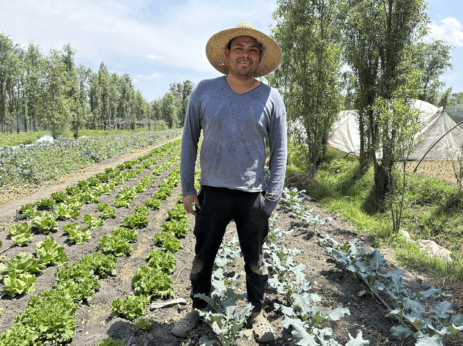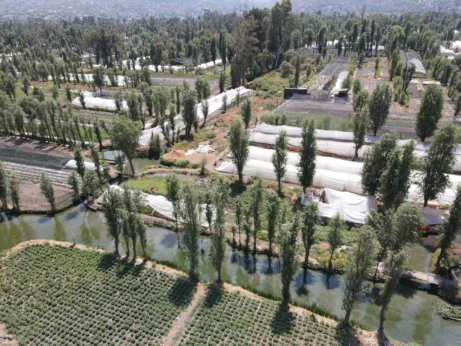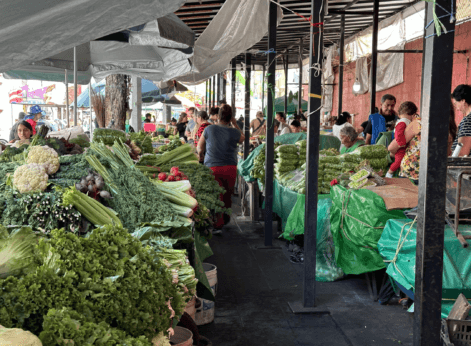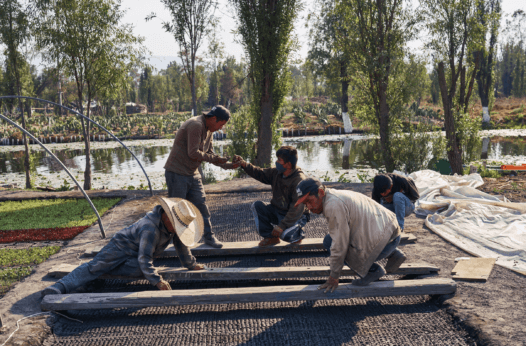Mexico’s Floating Gardens Are an Ancient Wonder of Sustainable Farming
Chinampas — an ingenious adaptation to the Valley of Mexico’s lake-filled landscape — could hold lessons for cities around the world.
Mexico’s Floating Gardens Are an Ancient Wonder of Sustainable Farming
Chinampas — an ingenious adaptation to the Valley of Mexico’s lake-filled landscape — could hold lessons for cities around the world.

by Antoli Studio / Arca Tierra
Standing amid rows of juicy, lime green lettuce and chunky florets of broccoli, Jose Paiz appears as if he could be the owner of a modern, high-tech farm. But the crops thriving here, in the suburbs of Mexico City, are part of a 1,000-year-old tradition.
“My ancestors were doing this before even the [Spanish] Conquistadors arrived in Mexico [in 1519],” says Paiz, while crouching down to pick up a handful of powdery soil from the chinampa, or “floating garden,” on which we are both standing.
These highly productive man-made island-farms, which can be found floating on lakes across the south of Mexico’s capital, date back to the time of the Aztecs or perhaps even earlier — and now proponents say that these ancient engineering wonders could provide an important, sustainable food source as the city faces historic drought.
“My grandparents taught me the methods,” adds Paiz, 32, who is the fifth generation of his family to be a chinampero working in San Gregorio Atlapulco, a traditional working-class neighborhood about 10 miles south of the center of Mexico City.

Experts say that these chinampas, which have been recognized as a UNESCO World Heritage site, are considered one of the most productive agricultural systems in the world. The artificial islands are built by gathering large amounts of soil from the bottom of the lake and placing it on top of reeds, grasses and rushes in a mass that rises above the water. Farmers then plant a fence of ahuejotes, Mexican willow trees, around the plot to naturally protect against erosion. This system means that the chinampa’s soil is constantly enriched by nutrient-filled sediment flowing in from the surrounding ditches and canals, yielding multiple harvests every year.
“In terms of agriculture, they are one of the best examples of how humans can work with nature,” says Lucio Usobiaga, founder of Arca Tierra, an organization providing local farmers in the area with technical and entrepreneurial support.
One of the first traces of the chinampas dates back to the 14th century, when the Aztecs arrived at the region of what is now modern-day Mexico City. There, they founded the settlement of Tenochtitlán — which would become one of the most powerful cities in all Mesoamerica — in the Valley of Mexico.
But as the Aztecs soon discovered, the valley’s boggy, lake-filled landscape was difficult to cultivate or build on. So they devised an ingenious plan to adapt to the surroundings: the chinampas.

A 2013 paper by North Carolina State University professor Matthew Teti found that in the 16th century, chinampa farms could produce 13 times as much crop as dry-land farming in the same area — a system that provided food for hundreds of thousands of people. Chinampas, the study said, are “one of the most intensive and productive agricultural systems ever devised.”
“Aztec planners created these vital waterways as integral to the existence of its cultural, physical, and spiritual, urban identity, rather than draining the water and excluding it from the urban experience,” it continued.
In the case of Jose Paiz, the age-old system is still reaping rewards today. He says that his 7,000 square meters of chinampa, for example, can produce as much as 100 kilograms of broccoli per day — which is sold alongside the yields of fresh herbs, spinach, chard, radishes, corn and kale at local markets in the south of Mexico City.
“I’m proud to be continuing the tradition of my ancestors,” he says.
Meanwhile, according to Arca Tierra, their network of seven producers in the region cultivates over 40,000 square meters of land, employing a total of 27 workers in the field and producing 3,650 kilograms per month. At some farms, as many as 95 varieties of vegetables and herbs are cultivated, underlining the fertility of the method. The production brings in over $4,000 per month in crop sales.

“At the beginning, it was mainly a commercial endeavor to source organic produce close to the city,” says Usobiaga, who supplies restaurants in Mexico City and began working with chinamperos in 2009. “But I learned they are very important in many regards and have historical and cultural importance.”
The design of the chinampas is particularly efficient in its use of water, which it can absorb and retain from the surrounding canals for long periods as well as allowing crops to draw from the groundwater directly, reducing the need for active irrigation.
This could prove hugely valuable for Mexico City and its 22 million residents, since water supplies have fallen to historic lows due to abnormally low rainfall partly attributable to climate change. And lessons learned from the chinampas could potentially help cities around the planet: the UN World Water Development 2024 Report found the number of people lacking access to drinking water in cities will likely reach two billion by 2050.
“The technical aspects of agriculture are innate to every place,” says Usobiaga. “But the way of thinking that created the chinampas, that sensibility, has to be appreciated and valued: To work with the flow of nature, the flow of the seasons. That is what we have to use to get us out of the problem we are in.”
The unique wetlands ecosystem is also home to two percent of the world’s and 11 percent of Mexico’s biodiversity, including the critically endangered axolotl, or Ambystoma mexicanum, an incredible salamander-like amphibian that is able to regenerate every part of its body — even parts of its vital organs such the heart and brain.
Meanwhile, the chinampas also provide a host of other benefits: they filter water, cool the city, sequester carbon, offer green space for locals, and are now a popular destination for tourists who take boats along the picturesque waterways.

The value of the chinampas was underlined during the Covid-19 pandemic, when, as the city’s major markets ground to a halt, the chinampas were able to provide healthy, locally-grown food. In some cases, sales more than doubled.
“People began to search for healthier food,” says David Monachon, a social sciences researcher at the National Autonomous University of Mexico who has researched the chinampas as a sustainable food source. “There was this focus on local economy and community. Many people didn’t make this connection before.”
Yet despite their immense value, the chinampas are under threat: rising urbanization means the chinampa landscape is being built on; pollution is dirtying the waters that feed them; younger generations are losing interest in agriculture; and agro-industry is under-cutting the small-scale producers in a price war.
“There are a lot of challenges and problems,” says Monachon, who is supporting a local cooperative of chinamperos to sell their goods via the Mercado Universitario Alternativo, or Alternative University Market. “But chinampas could feed the city.”
Now, only 20 percent of the 2,200 hectares of chinampas are in use, and only about 2.5 percent are being actively cultivated for farming food — the rest is being used for growing flowers and tourism. But Arca Tierra is helping to restore the chinampas — five hectares to date — and is training 15 young students in the required skills to cultivate them — the second, six-month cohort — while also carrying out research on the most effective techniques and productive crops to use on them.
“We have demonstrated that it can be done on a small scale,” says Usobiaga, who believes chinampas have the potential to produce enough of crops like lettuces, herbs and broccoli for all of Mexico City. “But the chinampas need support and investment from the government to scale up production.”

At Xochimilco market, the largest in the area, there is clear evidence of appetite for a resilient, local food system and signs that this ancient Aztec tradition can still bear fruit. The market bustles with traders and customers, spilling from the covered area out onto the streets.
Rosa Garcia, 47, is rushing around delivering lettuce, spinach, cilantro and broccoli to her 14 clients of the day. The produce, grown at her one-hectare chinampa at San Gregorio Atlapulco, is in high demand. Garcia says that each day her family-run farm can earn as much as 1,000 to 1,500 Mexican pesos ($60 to $90).
“I’ve been doing this since I was a girl,” says Garcia, ticking off the orders as they are dispatched. “It’s a system that works. Why do anything different?”
This article was originally published by Reasons to be Cheerful. Reasons to the Cheerful is a nonprofit online magazine covering stories of hope, rooted in evidence. You can read more from Reasons to be Cheerful here.
Follow us

This work is licensed under a Creative Commons Attribution-NoDerivatives 4.0 International License.
Want to republish a Modern Farmer story?
We are happy for Modern Farmer stories to be shared, and encourage you to republish our articles for your audience. When doing so, we ask that you follow these guidelines:
Please credit us and our writers
For the author byline, please use “Author Name, Modern Farmer.” At the top of our stories, if on the web, please include this text and link: “This story was originally published by Modern Farmer.”
Please make sure to include a link back to either our home page or the article URL.
At the bottom of the story, please include the following text:
“Modern Farmer is a nonprofit initiative dedicated to raising awareness and catalyzing action at the intersection of food, agriculture, and society. Read more at <link>Modern Farmer</link>.”
Use our widget
We’d like to be able to track our stories, so we ask that if you republish our content, you do so using our widget (located on the left hand side of the article). The HTML code has a built-in tracker that tells us the data and domain where the story was published, as well as view counts.
Check the image requirements
It’s your responsibility to confirm you're licensed to republish images in our articles. Some images, such as those from commercial providers, don't allow their images to be republished without permission or payment. Copyright terms are generally listed in the image caption and attribution. You are welcome to omit our images or substitute with your own. Charts and interactive graphics follow the same rules.
Don’t change too much. Or, ask us first.
Articles must be republished in their entirety. It’s okay to change references to time (“today” to “yesterday”) or location (“Iowa City, IA” to “here”). But please keep everything else the same.
If you feel strongly that a more material edit needs to be made, get in touch with us at [email protected]. We’re happy to discuss it with the original author, but we must have prior approval for changes before publication.
Special cases
Extracts. You may run the first few lines or paragraphs of the article and then say: “Read the full article at Modern Farmer” with a link back to the original article.
Quotes. You may quote authors provided you include a link back to the article URL.
Translations. These require writer approval. To inquire about translation of a Modern Farmer article, contact us at [email protected]
Signed consent / copyright release forms. These are not required, provided you are following these guidelines.
Print. Articles can be republished in print under these same rules, with the exception that you do not need to include the links.
Tag us
When sharing the story on social media, please tag us using the following: - Twitter (@ModFarm) - Facebook (@ModernFarmerMedia) - Instagram (@modfarm)
Use our content respectfully
Modern Farmer is a nonprofit and as such we share our content for free and in good faith in order to reach new audiences. Respectfully,
No selling ads against our stories. It’s okay to put our stories on pages with ads.
Don’t republish our material wholesale, or automatically; you need to select stories to be republished individually.
You have no rights to sell, license, syndicate, or otherwise represent yourself as the authorized owner of our material to any third parties. This means that you cannot actively publish or submit our work for syndication to third party platforms or apps like Apple News or Google News. We understand that publishers cannot fully control when certain third parties automatically summarize or crawl content from publishers’ own sites.
Keep in touch
We want to hear from you if you love Modern Farmer content, have a collaboration idea, or anything else to share. As a nonprofit outlet, we work in service of our community and are always open to comments, feedback, and ideas. Contact us at [email protected].by Peter Yeung, Reasons to be Cheerful, Modern Farmer
April 30, 2024
Modern Farmer Weekly
Solutions Hub
Innovations, ideas and inspiration. Actionable solutions for a resilient food system.
ExploreExplore other topics
Share With Us
We want to hear from Modern Farmer readers who have thoughtful commentary, actionable solutions, or helpful ideas to share.
SubmitNecessary cookies are absolutely essential for the website to function properly. This category only includes cookies that ensures basic functionalities and security features of the website. These cookies do not store any personal information.
Any cookies that may not be particularly necessary for the website to function and are used specifically to collect user personal data via analytics, ads, other embedded contents are termed as non-necessary cookies.
Is This Primary